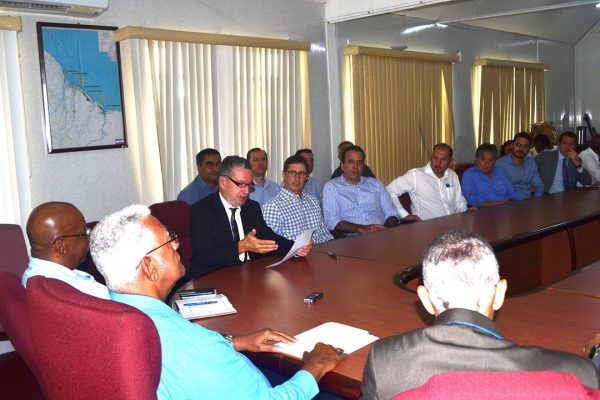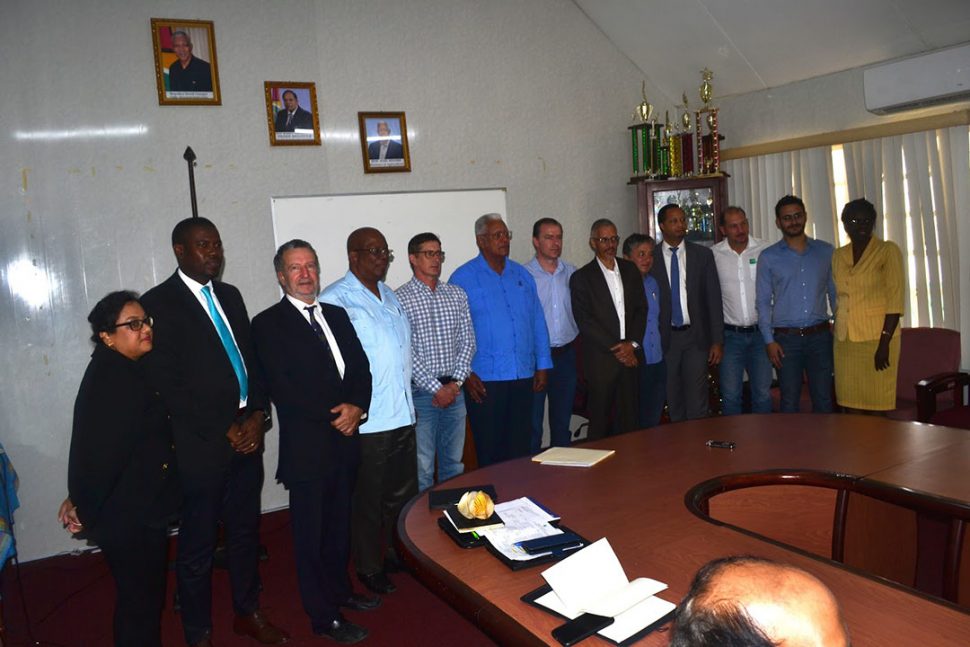A state-of-the-art mega-farm in the intermediate Savannahs in Region 10 is expected to begin early next year as a Brazilian investment group has signalled their intentions to start a huge three-phase project.
According to a press release from the Ministry of Agriculture, Guyana is set to become the bread basket of the Caribbean again as the Mano Julio Group from Brazil has presented their blue print for the establishment of the mega farm.
The outline of the project was presented to the representatives of the Government including Minister of Finance, Winston Jordan; Minister of Agriculture, Noel Holder; and Business Minister Dominic Gaskin at the Ministry of Agriculture’s boardroom yesterday morning.
The statement said that two video presentations were made, in which the Brazilian team showcased the transformation of the savannahs through the establishment of the mega farm concept.

“Job creation, the transfer [of] skills and knowledge, export to major markets throughout the Caribbean and EU (European Union) are just some of the benefits to be derived from this industrialisation of agriculture partnership between the Government of Guyana and a group of Brazilian investors,” the statement said.
The group has already tested the soil type with a successful crop of corn and soy bean and is expected to start cultivation early next year.
There has been growing concern in Brazil about the expansion of agriculture in their savannah lands.
The release said that Phase one will include the development of 5,000 hectares, out of the 50,000 hectares targeted under the entire life of the project, of corn and soybean which is also expected to eventually be taken through a value-added process to be translated into protein (livestock) animal feed and biofuel (bio-ethanol) in the project’s second and third phase.
“Meanwhile, given the challenges of climate change and other traditional crops grown on the coastland, government has, over the years, been stressing the need to move agricultural production more inland, hence the decision for the savannahs to be utilised. In the coming years the Region 10 intermediate savannah as well as the Rupununi savannah will be seen as the new agricultural frontier,” the release added.
It further explained that the investors highlighted that the Ebini intermediate savannah was sought out given its strategic location, approximately 100 miles from a main port, which will allow for ease of access to the North American and European markets. The intermediate savannah has been earmarked also because of the similarities in the soil type with what the Brazilian team are also working with, along with the good water supply, rainfall pattern and ready access to the Atlantic through the Berbice River.
“The billion-dollar investment also will see the creation of jobs for Guyanese, the transfer of technology and a boost to science-based agricultural endeavours such as the production of biogas, glycerine, (a) research institute and general infrastructural developments,” the statement said, while adding that the project is also expected to earn US$50 million of foreign currency annually while directly employing over 1,000 persons and indirectly employing 3,000.
Self-sufficient
The statement added that it is envisioned that once the project starts it will make Guyana self-sufficient within the first year, and by the end of the second year, the yield will be more than enough to supply the regional and international markets.
“Our sustainable agriculture method will seek to integrate three main objectives which will include a health environment, economic profitability and social and economic equity,” the release quoted Romeu Amaral, the legal representative of the investors as saying.
The investment will also result in the contracting of farming for persons with large plots of land that are currently being underutilised in the surrounding areas, which is expected to have an immediate and long term economic impact for the community.
The Ministry also envisages that as the economic activity and opportunities increase in the area, it will assist in attracting Guyanese from around the country.
“In addition, talks are in progress with the Environmental Protection Agency to ensure this project is rolled out in keeping with …strict environmental guidelines. The Ministry of Public Infrastructure will also be integrally involved as some key infrastructural projects will be vital in aiding this project to meet its full potential,” the release added.
It further noted that Jordan stated that he is enthusiastic with the prospects presented by the investors and promised the government’s support. However, he stressed the importance for the project to move from its concept stage to actual implementation.
“Oftentimes we see these wonderful presentations and after a while you hear nothing about it. This is a massive presentation which can materialise into something wonderful and I will commit our (government’s) full support,” the statement quoted Jordan as saying.
Gaskin also noted that the proposal is strategically aligned with the Government’s trajectory for agriculture to become a major contributor to the continued growth of the economy as it only currently contributes 16.2 per cent to Guyana’s overall gross domestic product (GDP).
Holder also added that currently there are mitigating factors in place to address the issue of climate change – moving the country’s agriculture base to higher grounds.
“We are conscious of the fact that this is not rice and sugar area, this is a quantum leap and we need to assistance we can get as the country in the long run will benefit,” Holder said.
The statement added that the next step in the process will result in the formulation of a working group which will include representatives from the Government, the Brazilian Embassy and the Mano Julio investment group. This move will then be followed by the drafting of a Memorandum of Understanding (MoU),
The investment group also included representatives from Granterra, NF Agriculture Inc. and Castilho Construction as well as representations from the Guyana Lands and Survey Commission, Ministry of Public Infrastructure, EPA and Go Invest.
Bird’s eye view
“On Wednesday November 28, the team visited the Intermediate Savannahs for a bird’s eye view of the land earmarked for development. Already a high level delegation visited Brazil and was given a tour of the operations in that country. The investment group will depart Guyana on Saturday,” the statement said.
A principal in NF Agriculture is Yucatan Reis, a Brazilian businessman whose ventures under the past and present administrations have raised questions. There was no mention of his name in the press release yesterday although he was present as the meeting and has been one of the key proponents of the mega farm.
Reis was written to by the Guyana Lands and Surveys Commission (GL&SC) earlier this year about the “non beneficial occupation” of at least one tenth of the 23,000 hectares of land he was given as part of an agreement he signed with the People’s Progressive Party/Civic (PPP/C) administration shortly before the 2015 General and Regional Elections.
According to documents seen by the Stabroek News, Reis was granted the state lands, located at Ebini on the right bank of the Berbice River, in March 2015 shortly before general elections that year.
The Memorandum of Understanding, with signatories being then Minister of Agriculture Leslie Ramsammy, Keith Burrowes for the Guyana Office for Investment (GO-Invest) and Reis, covers an agreement that the developers develop at least a portion of this and they would then be eligible for an additional 30000 hectares in what was to be a phased development project “with soya bean varieties from Brazil”.
The land is leased for a mere $25 per year, per hectare, for the first five years and the fee would be increased to $50 per hectare from the 6th year. The lease covers a 50-year period.
“After the first year of the lease expired, lands (GL&SC) visited and did not see any developments as promised in the agreement. GL&SC wrote to Reis about the findings but the letter was returned to its office with the post office noting that the person could not be found at the said address,” the source said.
“I am not sure if during that time he learned that the lands and surveys department was looking for him to discuss the breach in the contract agreement. They were supposed to utilize one tenth of the land by a certain time or it will be termed non beneficial occupation and that is a violation of the agreement,” the source added.






